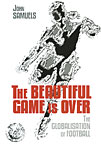 The Globalisation of Football
The Globalisation of Football
by John Samuels
Book Guild, £17.99
Reviewed by Roger Titford
From WSC 253 March 2008
The author confesses he started out with an analysis of the decline of midlands football but his publishers, seeking returns more global than those encompassed by the Nuneaton-Cannock-Worcester triangle, persuaded him to broaden his scope. He went away and did his reading, but his analysis is not particularly compelling.
The era of The Beautiful Game is never clearly identified. Professional League football has, according to some critic or another, been in a crisis since the day it began in 1888 and Samuels does not come close to identifying the supposed Garden of Eden moment. His serpent in all this is the growing power and commercialism of the elite four clubs and he seeks to make three main points.
The first and strongest is that poor boardroom leadership is a major factor in influencing clubs’ fortunes, an obvious point but one that has not been examined in detail and on a comparative basis. This is a difficult subject to tackle historically because of a lack of source material, but Samuels makes an interesting start. The second is that the forces of globalisation are bad and lead to a lack of competitive balance in the Premier League. This is the conventional, fan-centred, Observer-informed analysis that so many of us sympathise with. But when the analysis is peppered with “curiously”, “surprisingly” and “illogical”, the critical warning lights come on. It suggests the theory does not correspond with the reality.
The problem with “globalisation etc” is not that it is an economic problem; it’s that fans like us don’t like it – but other people (who we don’t respect as fans) will buy its output. There are some passing paragraphs on supporters, but the analysis is very much economics-driven (the data is easily available and it’s a well trodden path). What’s happening in football today in economic terms is largely successful, but in any transformation there are losers. Just as Bootle FC lost out to Everton at the outset of the spectator age, so Everton lose out to Liverpool at the outset of the digital age. Samuels’ “victim” focus is astonishingly narrow; Villa and the like, with barely a mention of Football League clubs.
There is little attempt at understanding the psychology or the social needs behind the increased support for the elite clubs. There is a hair-shirt tendency on the “fan” side of football to believe that all would be rosy if there were evenly funded clubs run by the democratically elected, all operating tightly regulated equality policies. But what really attracts larger numbers is tooth-and-claw battles between Roman emperor-style chairmen.
His final point is about the loss of social welfare if people do not support their local clubs. But this social welfare is displaced elsewhere, through fan websites, fantasy leagues and watching games together in pubs. The amount of social interactions caused by English football must have multiplied many-fold in the past two decades. For a future student of the game seeking a conventional view of the game’s “ills”, Samuels has written a useful, quasi-academic work. But for today’s informed reader the analysis is over-long at 367 pages and under-rewarding. And the search for the date of the beautiful game is not over.